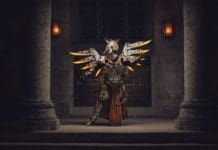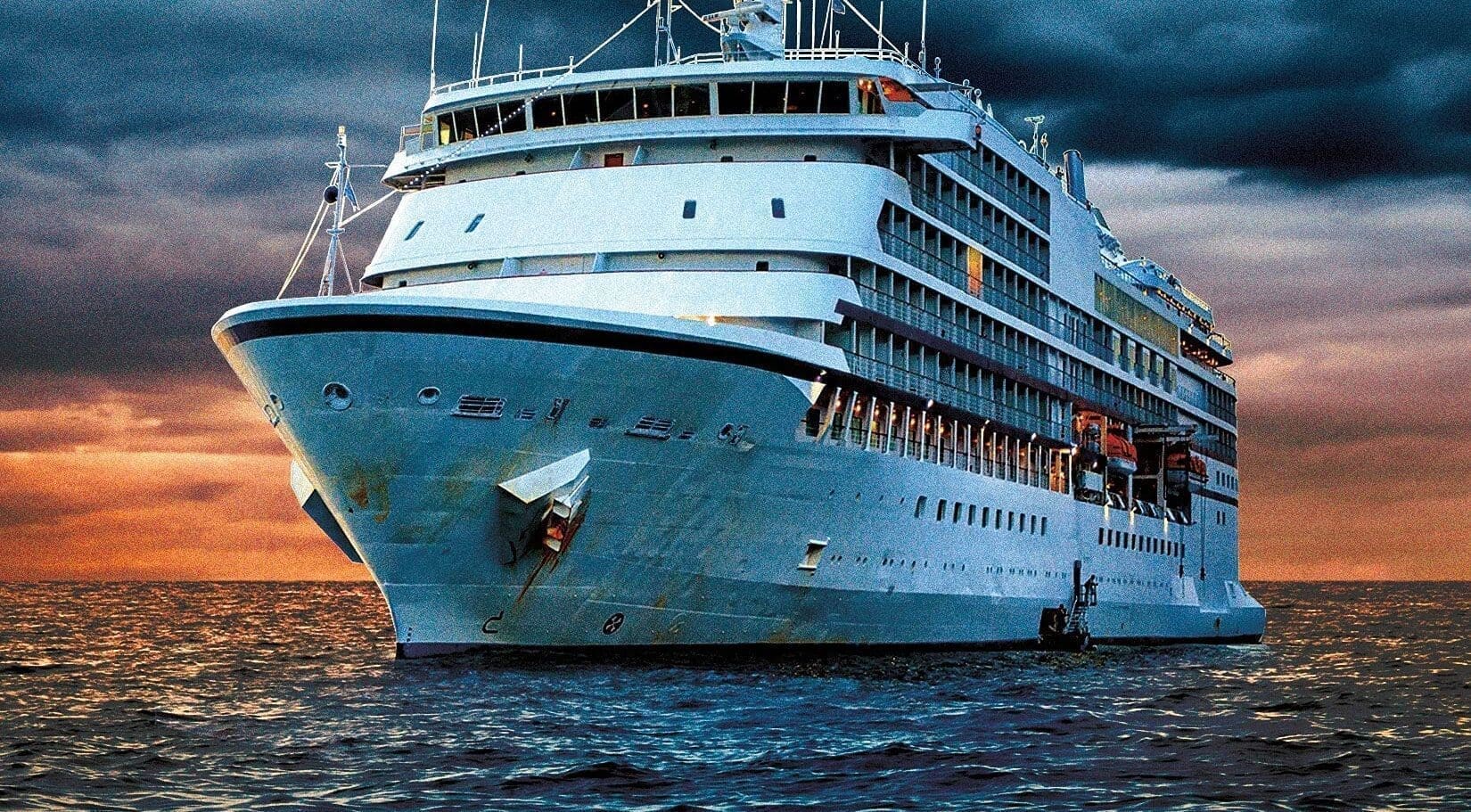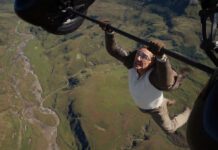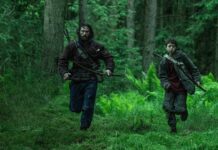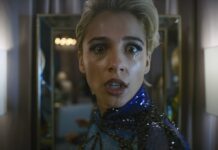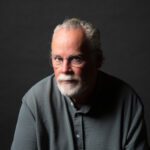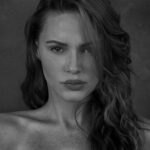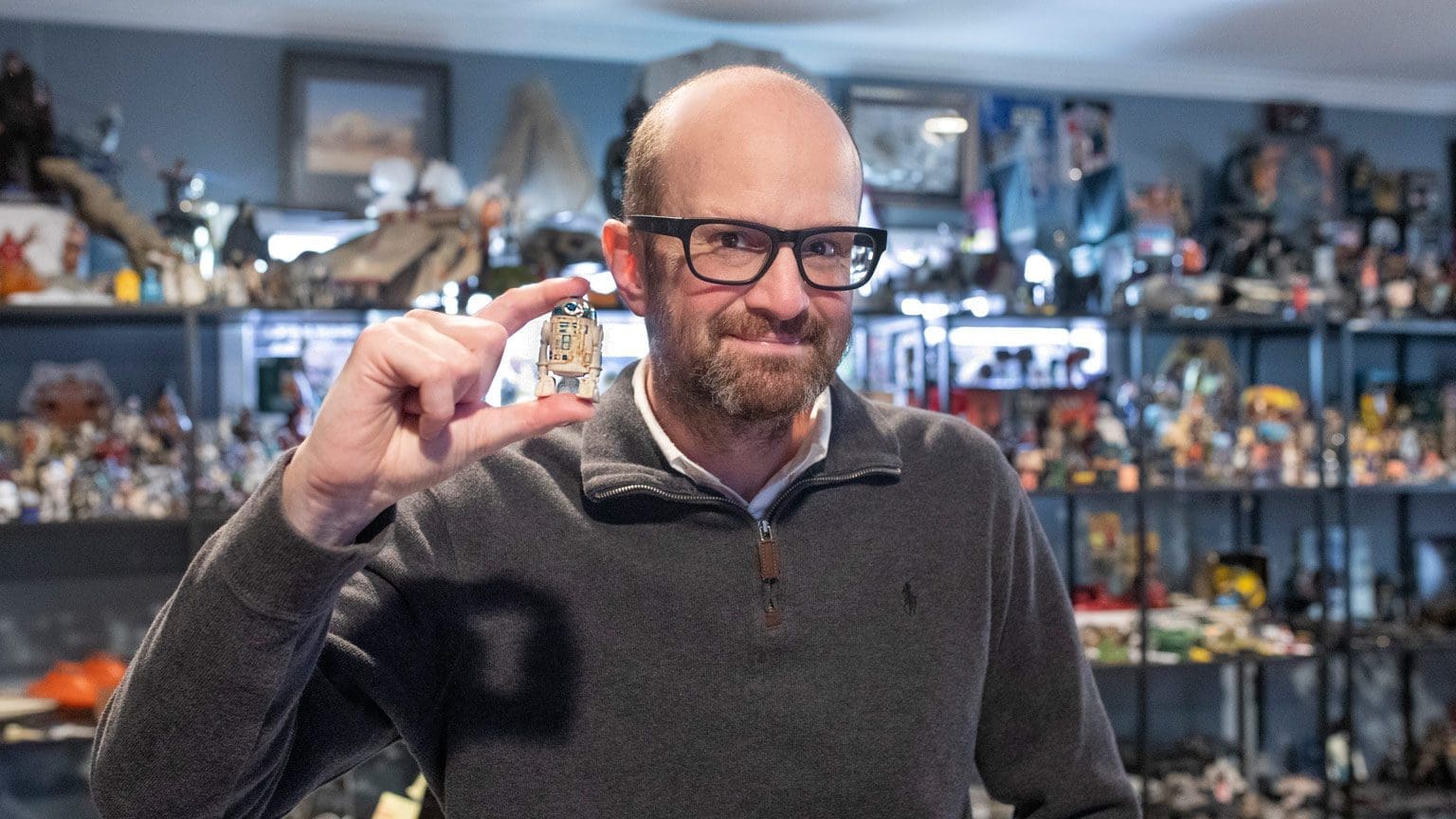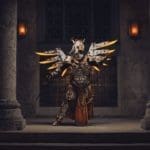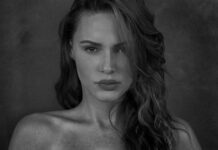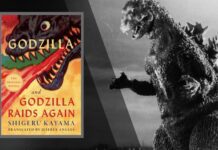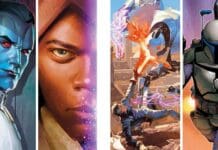Interview with Artist Peter Smith
When it comes to art, Peter Smith has pretty much done it all. He’s interned at Marvel; he’s worked at Disney; he’s taught art; he’s been a tattoo artist; he does commissions, from Batman to Pluto. Now, he’s creating his own comic book called the Chronicles of Zelaria. I sat down with Peter to talk about his education, his career, and his new comic book, and to ask him what advice he would give aspiring artists.
Scott (GNN): Okay, ladies and gentlemen, I am here with Peter Smith, artist, comic artist, and tattoo artist. Are there any other types of artists I’m missing?
Peter Smith: (PS): No, just illustration in general. I do a lot of illustration work. So comic books, realism, different things like that.
GNN: All right. So, let’s get in the way back machine before we get to the present, and let’s hit two key points: first, when did you figure out you were interested in art, in general? And then, number two, when did you figure out you could turn art from an interest into a career?
PS: I think I discovered that I really liked art when I was six. I went to see Star Wars and when we came home after that night, I drew a picture of C-3PO. I kind of remember all the details he had, the wires and stuff like that. My parents told me I had put a lot of detail into it. And I’ve been drawing ever since.
GNN: Wow. All right. So, starting at six. Now, jump to high school. Is that when you got to a point where you started to mold that into a career?
PS: Yeah. In high school, I had a really good art teacher. So, I learned a lot of different techniques, worked on a lot of different styles. I was a big Disney fan and I wanted to be a Disney animator, so that was also something that I went ahead and was looking into.
GNN: So, you started art at six, kept going with it into high school. Did you continue with art in college?
PS: I did, but before I did that, I went to Disney and I worked there for a while. I came back and went to the Columbus College of Art and Design, which was a school where Disney would show up to recruit animators or internships and stuff like that.
GNN: So, was the art teacher you had in high school, were they the one that kind of said to you, “Hey, you could do this as a career.”? When did that kind of come into it?
PS: Yeah. I think that’s when I realized that I wanted to do it. And like any kid, I was like, “Oh, I want to be a computer programmer,” at one point. “Oh, I’m going to do this. Oh, I’m going to do that.” And finally, kind of settled on art as I got into high school and, like I said, I had a really good art teacher that went ahead and just kind of steered me in that direction.
GNN: Okay, we’ll talk about this a little more later, but once upon a time, when some kid in elementary school, junior high, high school said, “I want to be an artist,” there was the concept of the starving artist. Because really there was the one medium. You sold your pictures somewhere or you taught art. Nowadays, it seems like there are more venues with which to get art seen. Is that a safe thing to say?
PS: Yeah. I mean, it’s very different pre-Internet opposed to now. There’s Instagram. There’s DeviantArt. There’s Facebook. There are so many different venues to where you can get your artwork out there. Making a website, making online portfolios. It becomes a lot more accessible and you’re able to reach a lot more people through using those venues.
GNN: For someone that’s maybe in junior high or high school, what would you say– formal training, going to school for art or self-teaching yourself? What are the pros and cons? I mean, some people can’t afford to go to school, but if you could, is it worth it? What are the benefits of going to an art school versus just trying to teach yourself?
PS: Well, I feel there are two different types of art colleges, when you get into the college level: one of those is a college that has an art program, and then the other one is an actual college that that’s what their focus is…on art. Somewhere like the Columbus College of Art and Design or Ringling College of Art and Design in Sarasota, Savannah College of Art and Design. The bigger companies end up going there. My school had Hasbro Toys, Hallmark, Lucasfilm, Disney, Pixar, American Greetings. You would get these bigger companies that will come in to look for artists, whereas if you have a college that only has an art program…I taught at a university for five years, and they ended up going ahead and kind of like, “Yeah, you can be an artist,” but it’s more of a fine art major, and they don’t really teach you how to network. So, a lot of that kind of falls by the wayside. I don’t want to say every college does that, but that was my experience in teaching there.
Now as far as younger kids…I’m actually the animation director at the Florida Film Academy, I teach grade school, middle school, and high school, and when they come into that environment I teach them at a level that I incorporate a lot of things that they would get from college into those programs so it helps them to become better than what they normally would be just going to school and learning art.
GNN: Because that’s one thing I’ve heard when I talked to authors and other artists, there are more places to be seen, but there are also more people there trying to be seen. So, you’re saying you’re getting, by going to art-specific schools, you learn how to get your art seen?
PS: Well, the thing is, especially when you’re talking about art college, you may leave high school, and you were a big fish in a little pond. When you go to an art college, like some of the ones I had mentioned before, you’re now a little fish in a big pond, but the benefit to you is that pushes you to become better and do your best, and I feel like you increase a lot more as far as your abilities and stuff go.
GNN: One thing I’ve always wondered, how much of art– obviously, this isn’t an exact science, and I’m not expecting an exact answer, but how much of it can be taught and how much of it is natural ability?
PS: Well, there are people that have a tremendous amount of natural ability, and, obviously, they’re going to go ahead and progress a lot faster. The best way to describe art and learning art is like learning a different language. There are certain rules and certain techniques and different things that you do, and, like with learning a different language, there are people that are going to get a very good grasp on it and progress very quickly, and then there’s going to be people that don’t really grasp it and, in some cases, are not able to get a grasp on it at all. And that would be the best comparison because when you look at art, you have to break it into skill; you have to break it into design; you have to break it into working with different materials, and so it definitely becomes a challenge.
GNN: All right. I read in your bio one of the interesting point, amongst others, that you were an intern at Marvel Comics…
 PS: I was. I interned in 1999 at Marvel Comics. I would encourage anybody going to our school– because I did that when was in college, that was my college internship. I was invited to go back, but I ended up getting a job, actually, before I even graduated. So, it was one of those things. I took a job as a graphic designer rather than going back to Marvel. You would have to move to New York and different things like that and uproot your life a little bit. But Marvel was great. We learned a lot of stuff. I got to work on several pages. I remember this one book that would come in and there were different numbers on Ultron’s head. So, my job was to go into Photoshop and take all the numbers off. It had something to do with the script and things like that, scanned a lot of pages in, did some drawing. You had to turn in a portfolio when you were done, but you got to work with the submissions editor hand-in-hand because they were right there and you would actually meet with them and get to do different things like that.
PS: I was. I interned in 1999 at Marvel Comics. I would encourage anybody going to our school– because I did that when was in college, that was my college internship. I was invited to go back, but I ended up getting a job, actually, before I even graduated. So, it was one of those things. I took a job as a graphic designer rather than going back to Marvel. You would have to move to New York and different things like that and uproot your life a little bit. But Marvel was great. We learned a lot of stuff. I got to work on several pages. I remember this one book that would come in and there were different numbers on Ultron’s head. So, my job was to go into Photoshop and take all the numbers off. It had something to do with the script and things like that, scanned a lot of pages in, did some drawing. You had to turn in a portfolio when you were done, but you got to work with the submissions editor hand-in-hand because they were right there and you would actually meet with them and get to do different things like that.
GNN: Did you get to meet any of the cool bigwigs at Marvel?
PS: Stan Lee wasn’t there when I was there, but I got to meet Tom Brevoort. Joe Quesada was there, and Jimmy Palmiotti…they were there.
GNN: Who did you admire when you were growing up? Where did you get your inspiration, your style? Did you mold it after anyone or do you kind of have your own?
PS: Yeah. I think one of the things when I started to develop my comic book style, right before that or while that was going on, I was in college and I went to the Chicago Comic Con and Ralph McQuarrie, who was the production designer for Star Wars, he did all the design work for the Millennium Falcon and stuff like that. He also painted a lot of backdrops that they used in the special effects. It was probably one of the few times that I actually got starstruck. I remember he asked me if he could see my portfolio and when I showed it to him he said, “You’re going to be a fantastic illustrator,” he goes, “Keep working because your stuff looks amazing.” And so that was…especially one of your heroes, it’s amazing when they say that to you. But I love Jack Kirby, Jim Lee, J. Scott Campbell, they all do really nice work. I love Adam Hughes’ work, and they definitely inspire my style and the work that I do.
GNN: Excellent. All right. Favorite character to draw? DC or Marvel guy? You worked at Marvel. Which–
PS: I like them both…
GNN: Oh. A very political answer.
PS: It’s hard to pick between one. I love Thor, but I love Superman. So, it’s really hard to pick one over the other. But yeah, favorite character to draw? The one that I get asked to draw the most is Batman, and then Spiderman also. Spiderman’s a big request. But I don’t know if I have a specific favorite because when I go in and do a character, like I just did a Darkseid, so I went back and I referenced a lot of Jack Kirby and referenced John Byrne and how he had done Darkseid and then I kind of did my own take on him. But definitely, get influenced by other artists and things like that.
GNN: Hardest thing you’ve ever been asked to draw?
PS: Let me think. That’s a tough one. Actually, this is going to sound really interesting but it’s been Pluto from Disney because of the pose that they wanted him in. They wanted him up on his hind legs folding his arms and I try and stay true any time I draw a Disney character or Dreamworks character. Anything like that from animation, I try and go back and use the model sheets they did so their anatomy’s correct and he’s tough to draw because they wanted him with his arms crossed sitting on his hind legs and it was a commission and there’s no reference for him out there. So, it’s you kind of have to go off the cuff and do the anatomy how you think it would look.
GNN: So, you’ve given a lot of great advice for young artists so far, but maybe you can provide a little more. Can you recommend any resources or books that can help artists? Is there anything that you’ve read? I know a lot of authors always talk about Steven King’s book on writing. Is there any book or resource you can think of?
PS: Yeah. There are definitely some different books out there. If you’re doing comics, one of the main books I would tell you to get is How to Draw Comics the Marvel Way. I think most comic artists to this day still have that book with them, and definitely had it when they were a kid. On a more artistic note that would definitely take over a wider array of it would be Andrew Loomis. Andrew Loomis was an illustrator and but he was also a teacher. So, he had done different books. One is. Figure Drawing for all it’s Worth. There’s a book out on head and hands. There’s another book he has called Creative Illustration and he was an anatomy master and that’s something, especially if you’re doing things on your own or trying to self-teach. Those are definitely good books to get that would help you to improve on anatomy and kind of put you in the right direction.
GNN: At the risk of shooting anyone down, are there just some people who can’t be artists, no matter how bad they want to be?
PS: I used to not think that that was the case. I used to say anybody could do this. Anybody could be an artist and when I was teaching at the university in Ohio. I taught at Youngstown State University. When I was teaching there, the chair of my department had brought this guy in who was a student and he wanted to be an artist so bad and I tried to start him off with even basic spheres and fruit and stuff like that and he just was not able to grasp it. It goes back to when we were talking about art being like a different language. There are some people that are not going to be able to grasp onto it. But for the most part, I think most people, if they wanted to be an artist, if they worked hard and were really paying attention and were good at taking criticism, that they could make it.
GNN: Is there something you could tell budding artists out there, maybe something that someone wouldn’t think about what you would recommend they do, and one thing that you would recommend they not do?
PS: One thing, I think, a lot of people have problems drawing, and I do this with my students now that come in, is hands. Drawing hands is very complicated. But the other thing with hands that a lot of people don’t realize is that as much as there’s expression in our face, we also use our hands to talk and gestures as well. So, it’s really important to understand how the hand works so that when you are drawing a character you have to remember, you’re also the actor. You’re the director. So, it’s great to be able to go ahead and put those together and use the hand along with the facial expressions. It makes it more believable, more realistic.
As far as what not to do, don’t try and draw everything out of your head. If there is something that you can reference, definitely pull reference on it. Like you may think that you have a complete grasp on, say something like a fire hydrant, that you know exactly what it looks like. And if you were to draw that fire hydrant out of your head, and then you would look at an actual picture of a fire hydrant, you’re definitely going to find there are some differences to it.
GNN: Okay, that’s some good advice. Maybe one last question on advice. Earlier, you mentioned going to an art school that focuses on art and the business of art. Do you have any advice on getting seen? Getting your stuff out there?
PS: A lot of that would be– I do a lot of comic book conventions. I have an Instagram. I have a Facebook page. DeviantArt and social media. Social media now is a big place for you to put your work, and if somebody sees it…for example, if you’re on Instagram, somebody may see a piece that you did and recommend it to somebody else. Same thing with Facebook. A lot of times if I make a post on Facebook, somebody will write in the comment section just a person’s name, that they should look at this. You know, tag a person in the picture.
GNN: All right. So, what do you think the biggest difference between art being a hobby and art being a career?
PS: One of the biggest things is that when it becomes a career, you have to remember, if you have art as a hobby you can draw when you want to. You don’t have a deadline. But when you draw as a career, you have to be able to draw even when you don’t want to. And that definitely separates the two. In fact, going to college, one of the things that I was told and that I saw, was that when you were a freshman, half of your class was going to be gone by the next year. So, when you go to a college that’s at that level of like CCAD or SCAD or Ringling, even CalArts is another good one out in California, and when you go ahead and you go to these colleges, again, you become a small fish in a big pond and they expect you to work, and they expect a lot out of you. And a lot of people, I think, go in thinking it’s going to be fun and find out that it’s a job and that that’s not the path for them.
GNN: How about you? Has it gotten to a point where it’s more of a job, or are you still loving it?
PS: No. I love it. I love drawing. I love being able to create. Love doing commissions for people. It’s very flattering when somebody likes your work enough that they come up to you and say, “Oh. Can you draw this for me? Can you draw Spider-Man for me? Can you draw Superman or Batman?” It’s definitely flattering.
GNN: Now, being an artist is one thing, drawing on a sheet of paper. Quite another thing to draw on a human being. Tell me about being a tattoo artist.
PS: I actually retired from tattooing a couple years ago because it’s very difficult, first of all, with creating a comic book, which I’m doing now, and doing the writing and the art and the character development and design takes a lot of time to do all of that stuff. When I was tattooing, it’s different than drawing because you have to remember everybody’s skin is different. So, if you’re tattooing somebody that’s 18 years old and goes to the gym every day, they’re going to be a lot easier to tattoo than somebody that’s 76.
GNN: That’s like drawing on a smooth piece of paper versus a wrinkly piece of paper.
PS: Yeah, their skin is coarser, and it’s harder to get the ink to stay sometimes, so yeah.
GNN: So, is there anything else that’s different?
PS: Yeah. If you have somebody that has a darker pigment in their skin, like somebody that’s of African descent is going to different than somebody if Irish descent. So, you’re going to have different colors that aren’t going to be able to stick out because what happens is tattoo ink is…the closest thing you could compare to it would be watercolor. So, even though it saturates, you’re still going to see the skin underneath it. So, if somebody has darker pigment in their skin, it’s harder to get certain colors to stay on them.
GNN: All right. So, let’s move the timeline up to the present and Crimson Fable Studios. Tell us a little bit about that and your new project, The Chronicles of Zelaria comic book. Tell us a little bit about it.
PS: Okay. Crimson Fable Studios is a publishing company, so there are a couple of other people that are business partners with my wife and me in that. And Chronicles of Zelaria is kind of the flagship book. It’s going to be coming out here shortly. I ended up creating this world that every fairytale that you know that exists, like Snow White, Cinderella, Sleeping Beauty, a lot of the Grimm’s fairytales. That’s where we took the reference from for those. So, I went back…and it was actually my daughter…we were walking through Target one day and she was about four, and I asked, “Who’s your favorite princess?” And she said, “Well, I would say Princess Aurora. Sleeping Beauty is my favorite, but I really like Wonder Woman, too.” So, I kind of thought about it for a second, and I had to explain to her that Wonder Woman was a princess, too, sure. And especially now with Disney, they seem to do a much better job, that the princesses are a lot more self-sufficient and able to take care of themselves and things like that. But some of the earlier ones, like Snow White and Sleeping Beauty and stuff like that, there’s always a prince that would come and save them, which is great, and they’re great stories, but I wanted to do something vastly different. So, the princesses that I’ve created are very self-sufficient, very independent. Sleeping Beauty was made in the 1600s, and when it came out it was originally called Sun, Moon, and Talia. Well, I made her more…she’s a princess, but she’s head chancellor to the Zelarian senate, so she has a position of power. And definitely, Snow White is just hardcore. She will mess you up! But the story itself starts off with the son of the Big Bad Wolf is hired to kidnap Sleeping Beauty. And that’s where the story starts off, and then it kind of picks up from there and kind of unveils a bigger plot behind the scenes and was a lot of fun to create.
GNN: I took a look at a preview and it’s got sort of a steampunk vibe.
PS: It has a very steampunk feel to it with a little bit of sci-fi touch to it.
GNN: Geppetto from Pinocchio is in there and what is he? He’s an inventor?
PS: Yeah. What happened with Geppetto, you have Vincent Geppetto and you have Alabaster Oz, and those two are the head scientists of Zelaria. They are the smartest guys on the planet. So, what ends up happening with Geppetto is that there was this event that happened called the Twilight Wars. And when I went back and researched Pinocchio, he literally lost his wife and his son. So, now, the Blue Fairy comes into play, where Geppetto’s son, he was in this horrible battle. His wife was killed and his son is dying, and she takes his basic essence: his personality, his soul, everything and captures it into this sphere. So, she goes ahead and Geppetto actually builds an android body to power, and this sphere is one of the things that powers the body, but he retains his personality and everything like that. And Geppetto being kind of just not happy with all the political rhetoric and stuff going on Zelaria, creates this sky hangar that’s basically a floating island where you can repair airships, do his experiments in private, and kind of stays out of all the political stuff that’s going on in Zelaria.
GNN: It sounds like you’ve got a lot of characters, a lot of storylines, and a pretty rich world. If someone wants to read more about the comic book or get their hands on one, it’s crimsonfablestudios.com, correct? I’m sure you also have a Facebook page.
book or get their hands on one, it’s crimsonfablestudios.com, correct? I’m sure you also have a Facebook page.
PS: Crimson Fable Studios is our Facebook page. And there’s an Instagram, Crimson Fable Studios, also.
GNN: All right. We got that. Now, I always have to throw this question in. Since this is an interview for Geek News Network, what do you geek out on? Obviously, comic books.
PS: I’m a big Star Wars fan and I collect toys.
GNN: Really? Coolest toy you have?
PS: Oh, that’s a tough one. I don’t think I can narrow it to one, but my ’70s and ’80s Star Wars collection is up there.
GNN: Movies, TV, what are you watching these days?
PS: I’m sitting with my kids and I’m getting them to watch a lot of ’80s movies. So, we watched Beetlejuice, Big Trouble in Little China, the original Star Wars trilogy, a lot of movies along those lines. Love The Avengers. We just got to go see Infinity War when it came out.
GNN: I met you at MegaCon in Orlando, Florida. You do a lot of conventions. I’m assuming you enjoy doing them. You talked earlier about people who meet you and are fans of your work through seeing you on Instagram and Facebook. Do you still enjoy the conventions? I’m assuming you wouldn’t be doing them if the gain was more than the pain.
PS: Well, I mean, it’s not even for making money off of it. The people that are fans– I like going out. I like meeting them. I like getting to talk to them just even chatting with them about different things. It’s great to know that there’s people out there that do like your work and to get to meet them and talk to them is really an experience that’s very unique and it sets the tone. I think some of the people that I’ve met that have been fans, you couldn’t ask for anyone better. They’ve all been just amazing.
 I did Heroes Con up in North Carolina and one of the commissions I’ve got to do up there was a gentleman had brought me a sketchbook and he said he wanted Lego Batman, but not in the Batman outfit, he wanted him wearing something different. So, we started kind of brainstorming and decided we were going to put him in the smoking jacket robe that he had on holding a lobster and a Lego fork. So, it’s Lego Batman with a Lego lobster on a Lego fork, and that was a lot of fun to do.
I did Heroes Con up in North Carolina and one of the commissions I’ve got to do up there was a gentleman had brought me a sketchbook and he said he wanted Lego Batman, but not in the Batman outfit, he wanted him wearing something different. So, we started kind of brainstorming and decided we were going to put him in the smoking jacket robe that he had on holding a lobster and a Lego fork. So, it’s Lego Batman with a Lego lobster on a Lego fork, and that was a lot of fun to do.
GNN: That’s awesome, I mean, an opportunity like that. So, if someone’s reading this and they’re like, “Hey, I would like to get out with my art and do a Con.” Do you have any tips for getting your art seen at a Con?”
PS: I think with that, you have to make sure that you have a decent display. You have to put your artwork somewhere where it’s visible, especially when you’re going ahead and you’re competing with a couple hundred other artists that are in Artist Alley. And I can’t even really say competing, but they’re there. So, people are going to choose what art they want to buy and what art they don’t, and you may have some great artwork that you’re taking to the convention, but if you lay a couple of portfolios or pieces out on the table, I don’t think it would be enough to stop someone to say, “Oh, I’m going to stop here and look.” We do a backdrop with different things that I’ve done on it. We do a couple of towers on the table so that people can see it. And then we have portfolios on the table, but I think initially when people go by, they look and they go, “Oh, look at that. Look at the backdrop that’s behind him.”
GNN: Coolest experience you’ve ever had at a Con? You ever get to meet any celebrities? They ever stop by?
PS: There’s actually two cool experiences I can think of. There’s when I got to meet Ralph McQuarrie like I said, he’s my hero. I’m a huge Star Wars fan, so to get to meet him. I have several pieces that he signed and I even have something he initialed because he got Parkinson’s later in life and wasn’t able to sign his full name. But to meet him and to get to speak with him was absolutely amazing. And he was a great guy and very fortunate that I got to meet him.
Another person who is absolutely amazing is Kevin Smith. And I remember, I was at a comic-con and I don’t know if he was on break or if he was just starting out. Clerks and Mallrats had come out, but I got to sit and talk to him for a good half an hour at his table. And he signed a Mallrats poster for me and was just a very, very cool guy to talk to.
GNN: Any upcoming cons for you? You said you have Tampa in early August.
PS: Yeah. And then I believe I am in Chicago. I’m going to do Madison. I’ll definitely be at MegaCon (in Orlando, Florida) next year. Yeah. I have a ton of them. The easiest way to find out where I’m going to be is to go to the website, crimsonfablestudios.com.
GNN: Well, that’s about it. Let’s get in one more plug. If people want to learn more about your comic, Chronicles of Zelaria, they can go to your website or Facebook page. Do you have Instagram? Twitter?
PS: I didn’t do a Twitter account yet. Everybody tells me I need a Twitter so I’ll get it up there eventually. For now, you can go to the Facebook. There’s also a lot of my artwork on Instagram. I’m the only one that posts on it so you can definitely go there. But Facebook, through the website, that’d be the easiest way to get ahold of me.
GNN: And how can people ask for commissions? Only at cons, or…
PS: They can put in for commissions through the website or they can email me, yeah.
GNN: Well, thank you very much for your time and look forward to reading the comic when it comes out and I appreciate you taking the time.
PS: Oh, no problem. Thank you.











